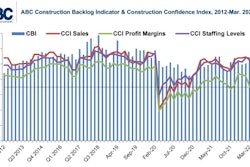
One of the two great benefits of landing negotiated work is the scheduling headache it relieves. Naturally the other benefit is the higher margins realized by avoiding price competition.
If you live by bid work, you are forced to bid on more work than you can handle. If you know the market really well, you will land one of every three or four bids you submit. The problem comes when you win two of three or three of four large bids that are scheduled for the same weeks and months.
This problem often arises when you lowered prices aggressively to offset getting whitewashed on the last eight plus bids. Most contractors are painfully familiar with this peaks-and-valleys sequence - going from being swamped with work to hurting for work to swamped with work and so forth. This pattern is the sign that the contractor is not managing his or her backlog effectively. He or she doesn't understand how to adjust price to smooth out the backlog.
How to Build Your Backlog
I'm going to share tips with you on how to better manage your backlog. When followed religiously you will discover that your stress level is greatly reduced and your bottom line ends up looking much healthier. We are going to touch on six topics:
- Making cold calls
- Maintaining relationships
- Knowing the going rate for work
- Following up after submitting bids
- Knowing when to touch the brakes
- Monitoring the time delay between bid, award and mobilization
Making cold calls
We've never met a contractor who didn't have a few clients at the bottom who were eroding company profitability. Those are the clients that you want to be looking to replace. In order to replace them, you need to find new, better clients. That means you need to be reaching out to clients you've never worked with before. That requires cold calling. This activity is called new business development, and every business should be doing it at all times. New business development is your first defense against peaks and valleys.
Maintaining relationships
You should never stop working on your relationships with your current clients. These companies know you. However, they often forget the things you've done for them in the past to help them out on projects - the change orders you've eaten because they didn't have any more money left in the job; the times you threw extra men on the job because they messed up the sequencing; the times you rode in to save them on a job that a competitor of yours bailed on; and so forth.
The more time you spend with the project managers, estimators and owners who run your clients' businesses the more often you'll get the plumb job or catch a break on one where complications arise.
You will also get advanced insight into upcoming projects so you can factor the timing of those opportunities into the aggressiveness of the bid opportunities that are currently sitting on your desk.
Know the going rate of work
I'm not sure which one of the first three errors is the most damaging; however, I do know this is the one that is most frequently made. I have yet to meet a contractor who could show me detailed tracking and analysis of the price that work has been going for. There is nothing magic about systematically monitoring the market's pricing.
The critical points to understand are that if your pricing and markups are spot on, you should be winning one of every three or four bids you pursue. If you are consistently winning less than one in five you are over priced.
Don't get caught up on the results of an individual bid. Look at the running trend. You will have dry spells where you lose nine of 10. You'll have other streaks where you win three of five. Know the running trend and price accordingly. Don't drop your price drastically just because you lost five in a row.
Follow up after submitting bids
This is such a simple thing to do. After the bid has been awarded to a GC, call him if you previously submitted a bid and find out where you stand. If the winner was a GC that you didn't provide a price to, call them up, introduce yourself and see whether they will accept your proposal. The project isn't lost until the GC or client signs a contract with your competitor.
How General Contractors Choose the Winning Sub
Pursue the lead aggressively. Work the relationship. Convince the client your company will perform better and be a better partner on the project. The real selling process starts when the GC is selected. Too many contractors believe that's when the selling process ends. That's a painful assumption to embrace.
Know when to touch the brakes
There are going to be times when you need to back off the aggressiveness of your pursuits. Taking on more work than your crews and operations management team can effectively manage is a recipe for disaster. When your crews and staff start getting booked up, reduce the number of bids you submit, submit mainly or only to your best clients, and raise your prices slightly. Continue to aggressively court new clients with cold calls - that is not a system you should ever apply the brakes to.
Monitor the time delay between bid and mobilization
Another very predictable aspect of your business is the typical time delay between bid closing and mobilization of your crews. The time delay will vary by trade, job size and client type (i.e. public vs. private). Only by keeping track of the bid date, the award date, the GC mobilization and your crews' mobilization will you truly be able to control your schedule and work load effectively. All leads and projects should be tracked in the same spreadsheet or database. Over time, consistent averages will reveal themselves.
Pulling it all together
Everyone speaks hopefully of putting systems in place so that their businesses will run smoothly. We've just described six of those systems. If those six systems are adopted and performed with rigid consistency your sales pipeline will stay full, your backlog will be kept right where you need it and you will be working for a better group of clients. If you have the will and means to implement these systems you have a great chance of growing your business soundly, profitably and predictably.




















